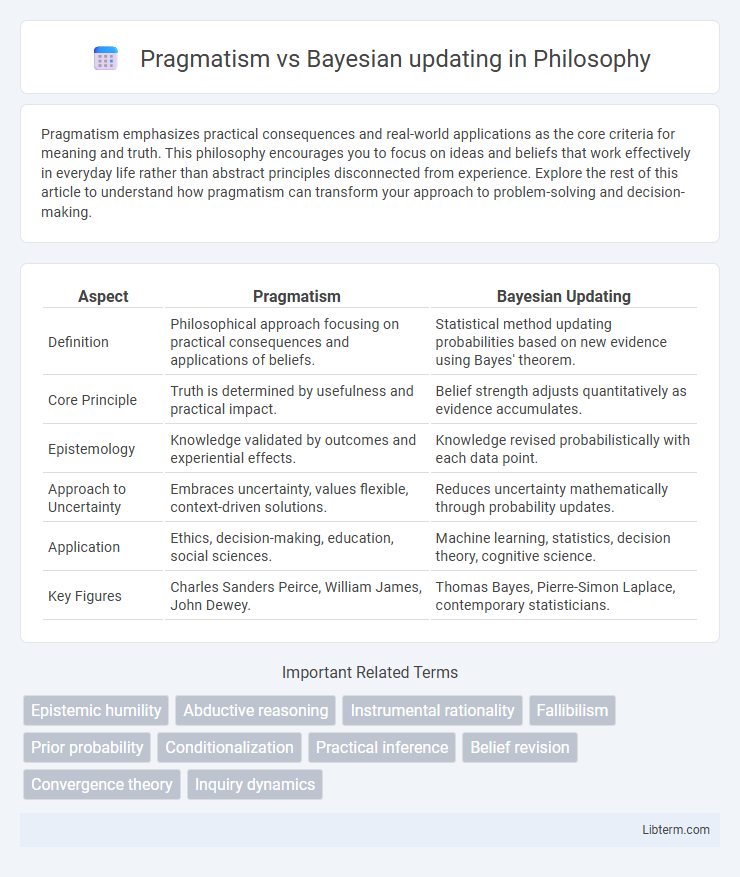Pragmatism emphasizes practical consequences and real-world applications as the core criteria for meaning and truth. This philosophy encourages you to focus on ideas and beliefs that work effectively in everyday life rather than abstract principles disconnected from experience. Explore the rest of this article to understand how pragmatism can transform your approach to problem-solving and decision-making.
Table of Comparison
| Aspect | Pragmatism | Bayesian Updating |
|---|---|---|
| Definition | Philosophical approach focusing on practical consequences and applications of beliefs. | Statistical method updating probabilities based on new evidence using Bayes' theorem. |
| Core Principle | Truth is determined by usefulness and practical impact. | Belief strength adjusts quantitatively as evidence accumulates. |
| Epistemology | Knowledge validated by outcomes and experiential effects. | Knowledge revised probabilistically with each data point. |
| Approach to Uncertainty | Embraces uncertainty, values flexible, context-driven solutions. | Reduces uncertainty mathematically through probability updates. |
| Application | Ethics, decision-making, education, social sciences. | Machine learning, statistics, decision theory, cognitive science. |
| Key Figures | Charles Sanders Peirce, William James, John Dewey. | Thomas Bayes, Pierre-Simon Laplace, contemporary statisticians. |
Introduction to Pragmatism and Bayesian Updating
Pragmatism emphasizes practical consequences and real-world applications as the core criteria for meaning and truth, grounding decisions in experiential outcomes. Bayesian updating relies on continuously refining probabilities based on new evidence, mathematically adjusting prior beliefs to improve decision-making accuracy. Both approaches offer dynamic frameworks for incorporating feedback and evolving knowledge, with pragmatism focusing on utility and Bayesian updating on probability revision.
Philosophical Foundations of Pragmatism
Pragmatism emphasizes the practical consequences of beliefs as the primary criterion for their truth, grounding knowledge in experience and action rather than abstract certainty. Contrastingly, Bayesian updating relies on formal probabilistic reasoning to revise beliefs based on evidence, embodying a mathematical framework for uncertainty. The philosophical foundations of pragmatism prioritize utility, context, and fallibilism, challenging the Bayesian emphasis on coherence and a priori probability assignments.
Core Principles of Bayesian Updating
Bayesian updating centers on the core principle of revising probabilities as new evidence emerges, ensuring decisions remain aligned with the latest data. This approach quantifies uncertainty through prior distributions, then refines beliefs systematically using Bayes' theorem. Unlike pragmatism, which emphasizes practical consequences and adaptable theories, Bayesian updating provides a mathematically rigorous framework to continually improve predictions and models.
Decision-Making Approaches: Pragmatism vs Bayesian Logic
Pragmatism in decision-making emphasizes practical outcomes and real-world consequences, often relying on experience and adaptability rather than rigid formal models. Bayesian updating uses probabilistic reasoning to revise beliefs based on new evidence, systematically optimizing decisions under uncertainty through Bayes' theorem. While pragmatism values flexibility and context-specific judgments, Bayesian logic provides a structured, mathematically grounded framework for iterative learning and decision refinement.
Handling Uncertainty: Pragmatic Strategies vs Bayesian Methods
Pragmatism approaches uncertainty by prioritizing practical outcomes and using heuristics to make decisions under ambiguous conditions, emphasizing adaptability over strict probabilistic accuracy. Bayesian updating quantifies uncertainty through prior distributions and likelihood functions, systematically refining beliefs by incorporating new evidence according to Bayes' theorem. While pragmatic strategies favor flexible, context-driven responses, Bayesian methods provide a formal, mathematically grounded framework for continuous belief revision.
Real-World Application Scenarios
Pragmatism in decision-making emphasizes practical outcomes and adaptability, influencing fields such as business strategy and policy development where real-world constraints and evolving situations dominate. Bayesian updating excels in scenarios with complex data structures and uncertainty, like medical diagnostics or financial forecasting, by continuously refining probabilistic models based on new evidence. Combining pragmatism and Bayesian methods enhances decision accuracy and responsiveness across industries requiring dynamic, data-driven solutions.
Strengths and Limitations of Pragmatism
Pragmatism excels in its focus on practical consequences and real-world applications, making it highly adaptable to evolving contexts and diverse problem-solving situations. Its strength lies in emphasizing actionable outcomes rather than rigid theoretical frameworks, allowing flexible decision-making based on current evidence and goals. Limitations of pragmatism include potential subjectivity and a lack of formal structure, which can reduce consistency and predictive accuracy compared to the mathematically rigorous Bayesian updating approach.
Advantages and Challenges of Bayesian Updating
Bayesian updating offers the advantage of systematically incorporating new evidence to continuously improve decision accuracy under uncertainty, making it ideal for dynamic environments and adaptive learning. It enables probabilistic reasoning that accounts for prior knowledge and observed data, enhancing predictive models in fields like machine learning and medical diagnostics. Challenges include computational complexity, sensitivity to the choice of prior distributions, and potential difficulty in interpreting posterior probabilities for non-experts.
Integrating Pragmatism and Bayesian Approaches
Integrating pragmatism and Bayesian updating enhances decision-making by combining Bayesian probability's systematic belief revision with pragmatism's emphasis on practical consequences and real-world effectiveness. This fusion supports adaptive learning through continuous data incorporation while prioritizing actionable outcomes based on contextual relevance. Consequently, it balances theoretical rigor with empirical flexibility, optimizing strategies in uncertain environments.
Conclusion: Choosing the Best Framework for Decision-Making
Pragmatism emphasizes practical outcomes and adaptive learning from real-world experiences, while Bayesian updating relies on systematically revising probabilities based on new evidence. Decision-making benefits from combining pragmatism's flexibility with Bayesian methods' quantitative rigor to handle uncertainty effectively. Selecting the optimal framework depends on the context, with Bayesian updating preferred for data-driven environments and pragmatism suited for dynamic, less predictable scenarios.
Pragmatism Infographic

 libterm.com
libterm.com